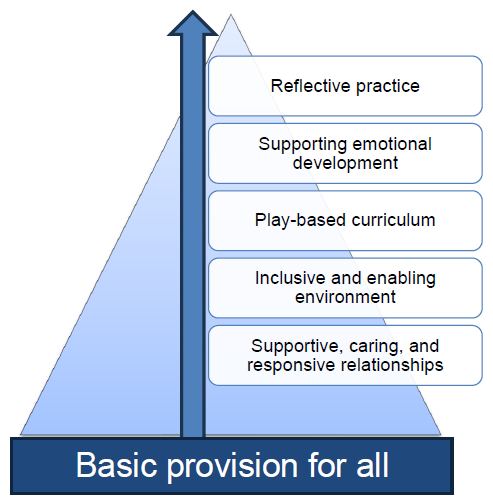Inclusive practice is a commitment to valuing and respecting the diversity of individuals, families and communities and must sit at the heart of early years practice. It ensures that every child has an opportunity to learn and grow, ensuring that children are treated as individuals and supported no matter their background or who they are.
“Inclusion: involves taking into account all children's social, cultural and linguistic diversity, including learning styles, abilities, disabilities, gender, family circumstances and geographic location, in curriculum decision-making processes. The intent is to ensure that all children's experiences are recognised and valued. The intent is also to ensure that all children have equitable access to resources and participation, and opportunities to demonstrate their learning and to value difference.” – 'Belonging, Being & Becoming: The Early Years Learning Framework for Australia'.

Supportive, caring, and responsive relationships – Adults must understand how to build positive relationships with children and their families as this is fundamental to wellbeing, learning and development for all within the provision. Leaders should also encourage positive relationships. All children and their families need to feel safe both physically and emotionally within the provision. As do adults working in provision.
Inclusive and enabling environment – All individual children’s experiences and interests should be seen within the environment. All children should be able to choose resources that they are interested in and naturally want to play with, and this should be supported by adults where appropriate. Are individual children’s interests reflected within the environment? Is the environment accessible to children? Is there a challenge for children? Are the Characteristics of Effective Teaching and Learning planned for?
Play-based curriculum – Children have a biological drive that leads them to play, a provider’s curriculum should reflect this. With the evidence from research suggesting that play is being lost, consider asking how your curriculum supports children’s opportunities for true play. Are you stopping and starting them frequently? Are children left to play alone for long periods without interaction? Or is there a lot of interference from adults during play? How does the planning cycle support children’s behaviour?
Supporting emotional development – Adults should prioritise supporting the development of children’s emotional development through positive interactions, and through routines and activities. This should be a priority for all.
Reflective practice – All staff should be aware of the importance of reflection and be given regular opportunities to reflect both individually and as part of the wider team. This should be important to all. The difference between a good practitioner and a bad one is the ability to reflect on practice and provision and make changes where it is needed.

